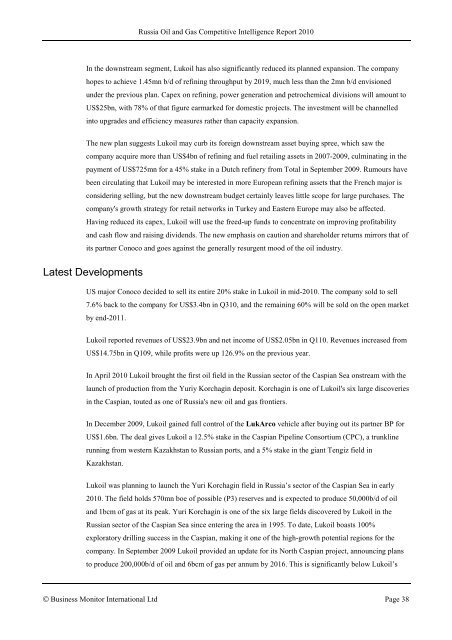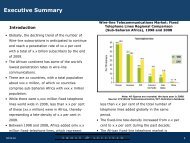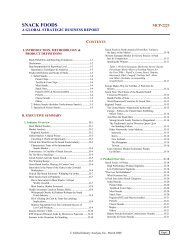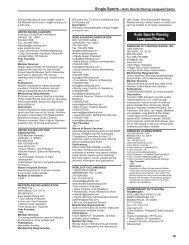the RUSSIA oil & gas competitive intelligence report - Report Buyer
the RUSSIA oil & gas competitive intelligence report - Report Buyer
the RUSSIA oil & gas competitive intelligence report - Report Buyer
You also want an ePaper? Increase the reach of your titles
YUMPU automatically turns print PDFs into web optimized ePapers that Google loves.
Russia Oil and Gas Competitive Intelligence <strong>Report</strong> 2010<br />
In <strong>the</strong> downstream segment, Luk<strong>oil</strong> has also significantly reduced its planned expansion. The company<br />
hopes to achieve 1.45mn b/d of refining throughput by 2019, much less than <strong>the</strong> 2mn b/d envisioned<br />
under <strong>the</strong> previous plan. Capex on refining, power generation and petrochemical divisions will amount to<br />
US$25bn, with 78% of that figure earmarked for domestic projects. The investment will be channelled<br />
into upgrades and efficiency measures ra<strong>the</strong>r than capacity expansion.<br />
The new plan suggests Luk<strong>oil</strong> may curb its foreign downstream asset buying spree, which saw <strong>the</strong><br />
company acquire more than US$4bn of refining and fuel retailing assets in 2007-2009, culminating in <strong>the</strong><br />
payment of US$725mn for a 45% stake in a Dutch refinery from Total in September 2009. Rumours have<br />
been circulating that Luk<strong>oil</strong> may be interested in more European refining assets that <strong>the</strong> French major is<br />
considering selling, but <strong>the</strong> new downstream budget certainly leaves little scope for large purchases. The<br />
company's growth strategy for retail networks in Turkey and Eastern Europe may also be affected.<br />
Having reduced its capex, Luk<strong>oil</strong> will use <strong>the</strong> freed-up funds to concentrate on improving profitability<br />
and cash flow and raising dividends. The new emphasis on caution and shareholder returns mirrors that of<br />
its partner Conoco and goes against <strong>the</strong> generally resurgent mood of <strong>the</strong> <strong>oil</strong> industry.<br />
Latest Developments<br />
US major Conoco decided to sell its entire 20% stake in Luk<strong>oil</strong> in mid-2010. The company sold to sell<br />
7.6% back to <strong>the</strong> company for US$3.4bn in Q310, and <strong>the</strong> remaining 60% will be sold on <strong>the</strong> open market<br />
by end-2011.<br />
Luk<strong>oil</strong> <strong>report</strong>ed revenues of US$23.9bn and net income of US$2.05bn in Q110. Revenues increased from<br />
US$14.75bn in Q109, while profits were up 126.9% on <strong>the</strong> previous year.<br />
In April 2010 Luk<strong>oil</strong> brought <strong>the</strong> first <strong>oil</strong> field in <strong>the</strong> Russian sector of <strong>the</strong> Caspian Sea onstream with <strong>the</strong><br />
launch of production from <strong>the</strong> Yuriy Korchagin deposit. Korchagin is one of Luk<strong>oil</strong>'s six large discoveries<br />
in <strong>the</strong> Caspian, touted as one of Russia's new <strong>oil</strong> and <strong>gas</strong> frontiers.<br />
In December 2009, Luk<strong>oil</strong> gained full control of <strong>the</strong> LukArco vehicle after buying out its partner BP for<br />
US$1.6bn. The deal gives Luk<strong>oil</strong> a 12.5% stake in <strong>the</strong> Caspian Pipeline Consortium (CPC), a trunkline<br />
running from western Kazakhstan to Russian ports, and a 5% stake in <strong>the</strong> giant Tengiz field in<br />
Kazakhstan.<br />
Luk<strong>oil</strong> was planning to launch <strong>the</strong> Yuri Korchagin field in Russia’s sector of <strong>the</strong> Caspian Sea in early<br />
2010. The field holds 570mn boe of possible (P3) reserves and is expected to produce 50,000b/d of <strong>oil</strong><br />
and 1bcm of <strong>gas</strong> at its peak. Yuri Korchagin is one of <strong>the</strong> six large fields discovered by Luk<strong>oil</strong> in <strong>the</strong><br />
Russian sector of <strong>the</strong> Caspian Sea since entering <strong>the</strong> area in 1995. To date, Luk<strong>oil</strong> boasts 100%<br />
exploratory drilling success in <strong>the</strong> Caspian, making it one of <strong>the</strong> high-growth potential regions for <strong>the</strong><br />
company. In September 2009 Luk<strong>oil</strong> provided an update for its North Caspian project, announcing plans<br />
to produce 200,000b/d of <strong>oil</strong> and 6bcm of <strong>gas</strong> per annum by 2016. This is significantly below Luk<strong>oil</strong>’s<br />
© Business Monitor International Ltd Page 38









